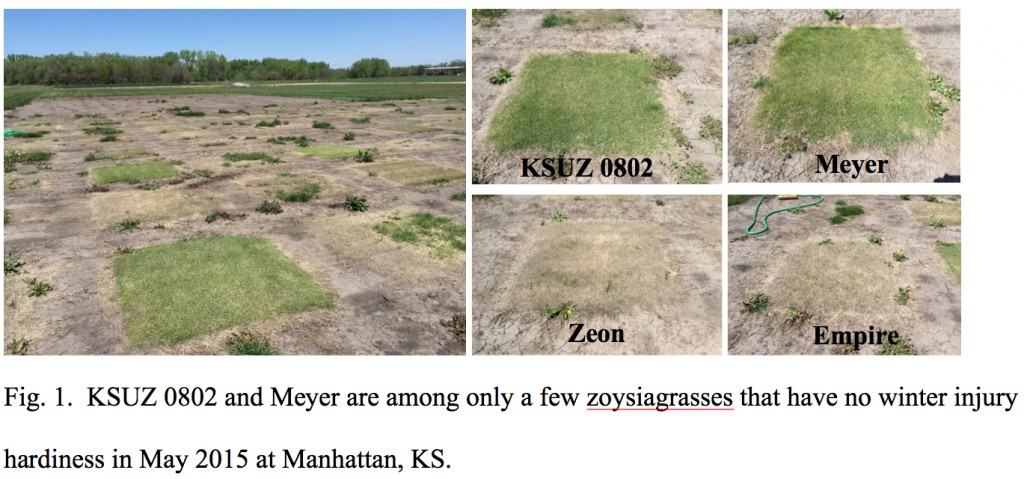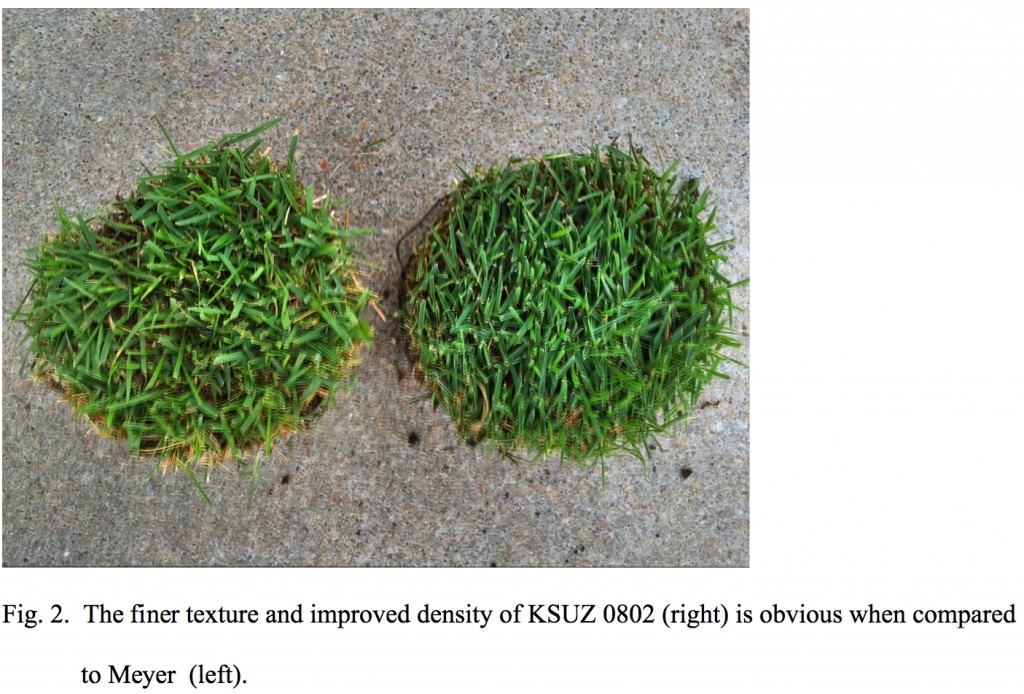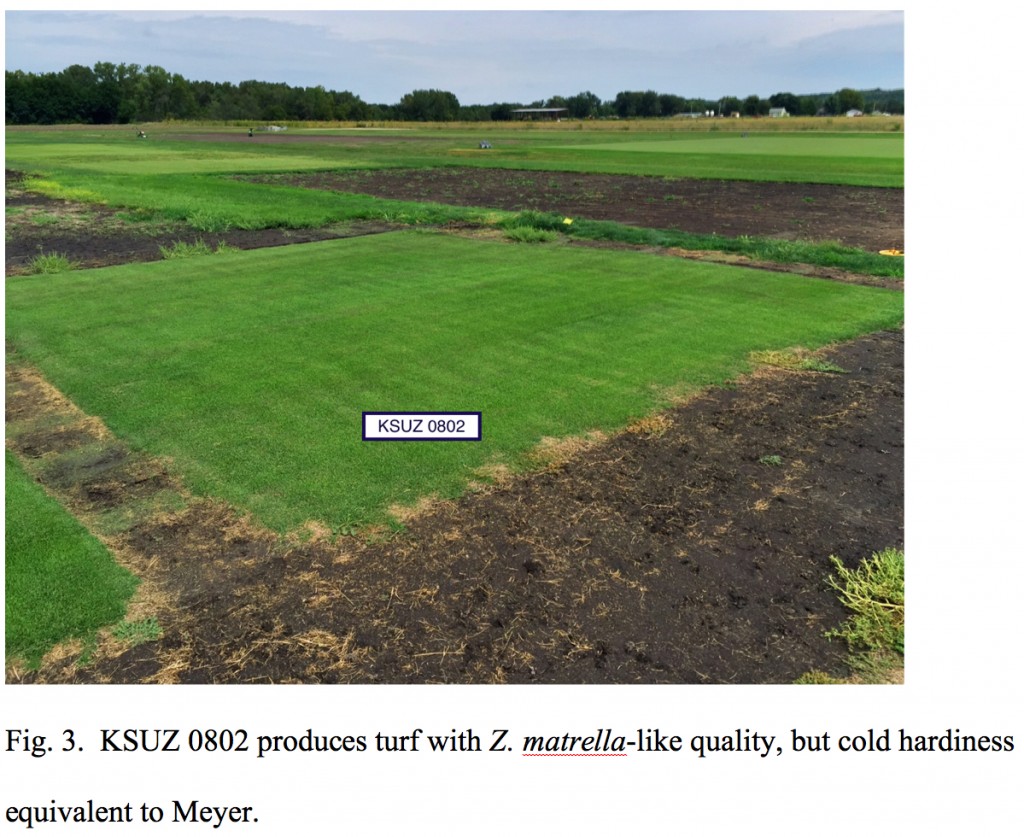‘Meyer’ zoysiagrass was released in 1952, and is still widely used in the transition zone due, in large part, to its excellent cold hardiness. However, as good as Meyer is, it has limitations, including a medium coarse leaf texture and inferior density compared to Zoysia matrella-type cultivars. In 2004, researchers at K-State and Texas A&M AgriLife Research-Dallas began working together to develop dense, fine-textured zoysiagrasses that are as cold hardy as Meyer. Eleven years later, the first zoysiagrass from this effort, KSUZ 0802 (a formal name is forthcoming), has been approved for release by K-State, and is expected to be approved for release by Texas A&M this autumn.
KSUZ 0802 is a fine-textured, cold-tolerant zoysiagrass hybrid co-developed by Texas A&M AgriLife Research, Dallas, TX and the Kansas Agricultural Experiment Station, Manhattan, KS. KSUZ 0802 is a F1 interspecific hybrid developed in 2001 from a cross between Z. matrella (L). Merr. cv. ‘Cavalier’ and an ecotype of Z. japonica Steud. named ‘Anderson 1’, a derivative of ‘Chinese Common’ which was collected from rough areas at Alvamar Golf Course in Lawrence, KS. Cavalier is a high quality Z. matrella cultivar, but lacks the hardiness to be used in the upper transition zone. By crossing it with Chinese Common, which is cold hardy, we have created a cultivar that has Z. matrella-like quality, but with good cold hardiness. KSUZ 0802 must be propagated vegetatively.
Initially, over 800 individual, genetically different hybrids were developed at Texas A&M AgriLife Research – Dallas in 2001. Grasses were planted in Manhattan, KS in 2004 and evaluated for quality and winter survival between 2004 and 2006. KSUZ 0802 was one of 31 hybrids selected for further evaluation at Manhattan in 2007 and 2008 under golf course conditions. These 31 were later narrowed to 7 hybrids, including KSUZ 0802, which were evaluated at nine locations in the transition zone under typical lawn or golf course fairway management conditions from 2009 to 2012. These locations were Wichita and Manhattan, KS; Columbia, MO; Fletcher and Jackson Springs, NC; Stillwater, OK; Knoxville, TN; Virginia Beach, and Blacksburg, VA; and Dallas, TX.
KSUZ 0802 has repeatedly demonstrated cold hardiness equivalent to Meyer in replicated field plot research (Fig. 1). Following a severe winter in 2013 in Manhattan, KS, KSUZ 0802 and Meyer had >99% survival; conversely, ‘Empire’ (Z. japonica) had 78% survival, ‘Zeon’ (Z. matrella) had 72% survival, and a large number of experimental Z. matrella selections had <50% survival (Thompson et al. 2013). Freezing tolerance studies conducted under controlled conditions at K-State showed that KSUZ 0802 had an LT50 (lethal temperature that kills 50% of the tillers) that was statistically similar to Meyer in two consecutive winters (Okeyo et al., 2011). Observed LT50 ranged from – 8.4 to – 10.3º C (17 to 14 º F) for KSUZ 0802 and from – 10.7 to – 12.0º C (13 to 10 º F) for Meyer. Based upon the results from research, KSUZ 0802 can be used as far north as zone 6a on the USDA Plant Hardiness Zone Map (http://planthardiness.ars.usda.gov/PHZMWeb/).
In general, KSUZ 0802 has a finer leaf texture and better density relative to Meyer, which results in better overall turf quality (Fig. 2 and 3). Average turf quality of KSUZ 0802 (average rating of 6.1 on a 1 to 9 scale) was higher than Meyer (average rating of 5.5) maintained at lawn height in Wichita, Kansas; Jackson Springs, NC; Stillwater, OK; Dallas, TX; and Blacksburg, VA. At fairway height, quality of KSUZ 0802 (average of 6.9) was superior to Meyer (average of 5.6) at the two locations it was evaluated – Manhattan, KS and Stillwater, OK.
To summarize aforementioned results, and other research that has been with KSUZ 0802, its freezing tolerance, spring green-up and fall color retention are equivalent to Meyer, but it has a finer leaf texture than Meyer. KSUZ 0802 is also superior to Meyer for turfgrass quality and resistance to bluegrass billbug (Sphenophorus parvulus) damage. KSUZ 0802 is well suited for use on golf course fairways and tees, home lawns, and other recreational areas in the transition zone. It is currently under evaluation by sod growers in Kansas, Oklahoma, Texas, Illinois, Indiana and North Carolina. If you have questions about KSUZ 0802, or interest in producing it, contact either Jack Fry (jfry@ksu.edu) or Ambika Chandra (a-chandra@tamu.edu).
Acknowledgements
Funding tosupport the development of KSUZ 0802 came from a number of sources, including the Kansas Agricultural Experiment Station, Texas A&M AgriLife Research, the Kansas Turfgrass Foundation, the Heart of America Golf Course Superintendents Association, the Kansas Golf Course Superintendents Association, and the Kansas Golf Association. also acknowledge others who contributed to this research: Genovesi, Meghyn Meeks, and Milt Engelke, Texas A&M AgriLife Research; Qi Zhang,Okeyo, Jason Griffin, and Linda Parsons,-State; Justin Moss, Oklahoma State Univ.; Erik Ervin, Virginia Tech; Xi Xiong, Univ. of Missouri; Susana Milla-Lewis, North Carolina State Univ.; andBrosnan, Univ. of Tennessee. you!
(Jack Fry and Ambika Chandra)



